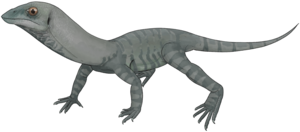Biology:Tanystropheidae
| Tanystropheidae | |
|---|---|

| |
| Skeletal reconstruction of Tanystropheus longobardicus | |

| |
| Life restoration of Langobardisaurus | |
| Scientific classification | |
| Domain: | Eukaryota |
| Kingdom: | Animalia |
| Phylum: | Chordata |
| Class: | Reptilia |
| Clade: | Archosauromorpha |
| Family: | †Tanystropheidae Gervais, 1858 |
| Genera[1] | |
|
See text | |
Tanystropheidae is an extinct family of archosauromorph reptiles that lived throughout the Triassic Period, often considered to be "protorosaurs". They are characterized by their long, stiff necks formed from elongated cervical vertebrae with very long cervical ribs. Members of the group include both terrestrial and aquatic forms. While some tanystropheids were small lizard-like animals, other tanystropheids such as Tanystropheus were large animals that had necks that were several meters long, longer than the rest of their bodies.
Tanystropheids are known from Europe, Asia (Russia , China , and Saudi Arabia), North America[2] and probably South America (Brazil ).[3] The presence of tanystropheids in Europe and China indicate that they lived along much of the coastline of the Tethys Ocean.[4] However, species in western North America are found in terrestrial deposits, suggesting that as a group, tanystropheids were ecologically diverse.[2]
Relationships among tanystropheid species have been difficult to resolve because most specimens were flattened during fossilization and are preserved two-dimensionally. Three-dimensional fossils are known from Europe and North America.[2]
Phylogeny
In 2021, a phylogenetic study was conducted by S. Spiekman, N. Fraser, and T. Scheyer in an attempt to clarify the systematics of "protorosaur" groups. A total of 16 individual trees were found using different character scoring methods and unstable OTU exclusions. The following cladogram shows the results of analysis 3A. In this analysis, ratio and ordered characters are treated as such, and 5 out of 40 OTUs (Macrocnemus obristi, Elessaurus gondwanoccidens, Tanytrachelos ahynis, Tanystropheus “conspicuus”, and Raibliania calligarisi) are pruned after the analysis to minimize polytomies:[5]
| Archosauromorpha |
| |||||||||||||||||||||||||||||||||||||||||||||||||||||||||||||||||||||||||||||||||||||||||||||||||||||||||||||||||||||||||||
List of genera
- †Amotosaurus
- †Augustaburiania
- †Cosesaurus
- †Dinocephalosaurus?
- †Elessaurus?
- †Exilisuchus?
- †Fuyuansaurus?
- †Gracilicollum[6]
- †Gwyneddosaurus (possible chimera of Tanytrachelos and a coelacanth; thus Gwyneddosaurus is a possible senior synonym of Tanytrachelos)[7][8]
- †Langobardisaurus
- †Luxisaurus[9]
- †Macrocnemus
- †Ozimek?[10]
- †Pectodens?
- †Protanystropheus?
- †Raibliania
- †Sclerostropheus?
- †Sharovipteryx?[10]
- †Tanystropheus
- †Tanytrachelos
References
- ↑ Fossilworks
- ↑ 2.0 2.1 2.2 Pritchard, Adam C (2015). "Late Triassic tanystropheids (Reptilia, Archosauromorpha) from northern New Mexico (Petrified Forest Member, Chinle Formation) and the biogeography, functional morphology, and evolution of Tanystropheidae". Journal of Vertebrate Paleontology 35 (2): e911186. doi:10.1080/02724634.2014.911186. Bibcode: 2015JVPal..35E1186P.
- ↑ Tiane Macedo De Oliveira; Daniel Oliveira; Cesar L. Schultz; Leonardo Kerber; Felipe L. Pinheiro (2018). "Tanystropheid archosauromorphs in the Lower Triassic of Gondwana". Acta Palaeontologica Polonica 63 (4): 713–723. doi:10.4202/app.00489.2018.
- ↑ Rieppel, O.; Jiang, D. Y.; Fraser, N. C.; Hao, W. C.; Motani, R.; Sun, Y. L.; Sun, Z. Y. (2010). "Tanystropheus cf. T. Longobardicus from the early Late Triassic of Guizhou Province, southwestern China". Journal of Vertebrate Paleontology 30 (4): 1082. doi:10.1080/02724634.2010.483548. Bibcode: 2010JVPal..30.1082R.
- ↑ Spiekman, S. N. F.; Fraser, N. C.; Scheyer, T. M. (2021). "A new phylogenetic hypothesis of Tanystropheidae (Diapsida, Archosauromorpha) and other "protorosaurs", and its implications for the early evolution of stem archosaurs". PeerJ 9: e11143. doi:10.7717/peerj.11143. PMID 33986981.
- ↑ Wang, W.; Spiekman, S. N. F.; Zhao, L.; Rieppel, O.; Scheyer, T. M.; Fraser, N. C.; Li, C. (2023). "A new long-necked archosauromorph from the Guanling Formation (Anisian, Middle Triassic) of southwestern China and its implications for neck evolution in tanystropheids". The Anatomical Record. doi:10.1002/ar.25216. PMID 37029530.
- ↑ Olsen, P. E.; Flynn, J. (1989). "Field guide to the vertebrate paleontology of Late Triassic rocks in the southwestern Newark Basin (Newark Supergroup, New Jersey and Pennsylvania)". The Mosasaur 4: 1–35.
- ↑ Olsen, P. E.; Baird, D. (1986). "The ichnogenus Atreipus and its significance for Triassic biostratigraphy". in Padian, K.. In The Beginning of the Age of Dinosaurs: Faunal Change across the Triassic-Jurassic Boundary. Cambridge: Cambridge University Press. pp. 61–87. ISBN 0-521-36779-4.
- ↑ Lu, Y.-T.; Liu, J. (2023). "A new tanystropheid (Diapsida: Archosauromorpha) from the Middle Triassic of SW China and the biogeographical origin of Tanystropheidae". Journal of Systematic Palaeontology 21 (1). doi:10.1080/14772019.2023.2250778. Bibcode: 2023JSPal..2150778L.
- ↑ 10.0 10.1 Adam C. Pritchard; Hans-Dieter Sues (2019). "Postcranial remains of Teraterpeton hrynewichorum (Reptilia: Archosauromorpha) and the mosaic evolution of the saurian postcranial skeleton". Journal of Systematic Palaeontology 17 (20): 1745–1765. doi:10.1080/14772019.2018.1551249. Bibcode: 2019JSPal..17.1745P.
Wikidata ☰ Q6138746 entry
 |

